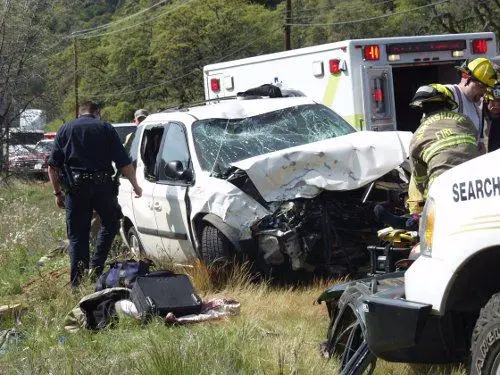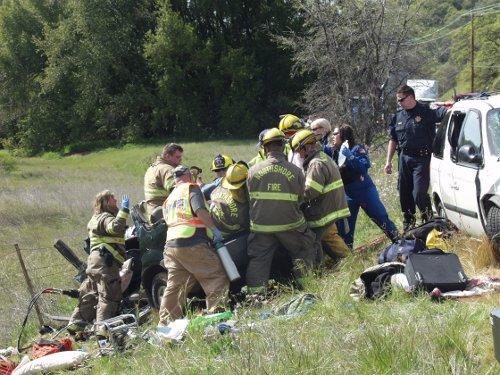
Upper Lake, Calif., resident Gary Lewis, who served as District 3 supervisor for eight years, ending in 2006, is back in the race in 2010. Lewis said he enjoys helping people solve problems. Courtesy photo.
UPPER LAKE – A former county supervisor says he's back in the race this year.
Gary Lewis, 66, of Upper Lake has joined the race for District 3 supervisor, a seat he won in 1998 and held through 2006.
In the race along with Lewis are two other Upper Lake residents – the incumbent, Denise Rushing, who defeated Lewis in a hotly contested 2006 race, and Robert Hesterberg.
Although the 2010 race for District 3 supervisor has three candidates as it did in 2006 race – Shalean Smith, another Upper Lake resident, was the third person in the 2006 election – the two races are notably different in tone and the amounts of money raised so far.
In 2006, Lewis and Rushing ran to November in a campaign that saw more than $100,000 raised between the two top candidates, which Lewis said is a county record.
That campaign had not just cash but rhetoric, as the two campaigns battled over the Northshore, how it had been led and its hopes for the future. Lewis also was criticized for using a county cell phone to make personal calls, which he said totaled $150 over several years and which he repaid.
“That's what happens when you don't pay attention,” he said.
This year, Lewis said he's taking a far different, more “subdued” approach. “I'm not running against Denise, I'm running for Gary. So I don't have any bad things to say about anybody,” he said.
He also doesn't plan to raise anywhere near what he did in 2006, when the county had a different economy,he said. Lewis in fact filed a form with the Registrar of Voters Office saying that he does not expect to raise more than $1,000.
Explaining that decision, he said that, considering the economy currently, it would be hypocritical to ask people for money. Instead, he's taking a word-of-mouth approach.
“If people want to elect me, that's fine, if not, that's OK,” he said.
Lewis purchased land in Lake County in 1968 and moved here permanently in 1974. He and wife, Darla, live on a 20-acre property next door to the Mendocino National Forest and bordered by Salt and Middle creeks.
Noting that he believes in taking care of one's land, he said he's kept the property native, with its big pines, Douglas fir and madrone trees. He said bears, turkeys, foxes and other wild critters make their home there as well.
In the nearly four decades that he's lived in the county, Lewis said he's seen the population grow form about 26,000 to nearly 68,000 now. He favors incremental growth.
“I wouldn't want to see it just get paved over,” he said. “None of us want to see that.”
He's owned a hardware store in Upper Lake which he later sold – and which he said he wished he hadn't, as it later closed – before running a business selling pumps and water systems that he also later sold and now is operated at AAA Pumps.
From there he went into financial planning, a job that took him away from Lake County too much. So he came home and applied for a job in the county's Code Compliance Division, where he worked from 1993 to 1997. He said it was an interesting job and he learned a lot doing it.
When he heard that then-Supervisor Louise Talley wasn't going to seek reelection, he decided to run, and took office in 1999.
During his eight years in office he said he took more than 8,000 calls and was proud of the fact that he always returned them and tried to help people.
He said he never dreamed he would be in government, but he enjoyed the work. “I really have a passion for just solving problems,” he said, noting that's one of the reasons he jumped into this year's race.
“I didn't join in because I have animosity or anger. I am perfectly content in my lifestyle,” he said.
Today, he works in sales and marketing for Mendo Mill, chairs the Northshore Business Association, takes part in activities with Upper Lake's town council and is chair of the local Resource Advisory Committee, which helps determine projects paid for by funds received the Secure Rural Schools and Community Self-Determination Act of 2000, which distributes money to areas based on historic timber receipts.
He's also a member of an advisory commission that makes recommendations to the federal government regarding best usages for lands on the coast. “It's been a lot of fun,” he said of working with the group.
Lewis, who was treated for prostate cancer several years ago, said he's doing well, with no signs of the cancer's recurrence, and he's taking care of himself, exercising and eating right to stay healthy.
A low key campaign
He said he's doing his campaign work on evenings and weekends, speaking to people about their concerns, many of which center around the economy. However, Lewis said he has no keys issues or platforms.
He said he's looking at the total picture of tourism, agriculture, seniors needs and young kids “and how it all comes together.”
Lewis sees the county's fiscal challenges, and how county government will need to tighten its belt and possibly lay off people at a time when unemployment locally is higher than he's ever seen it.
At his church, Upper Lake United Methodist, where he's chair of the board of trustees, they're seeing more people seeking help, with church members donating canned food and clothing to help community members in need. Increasingly, neighbors are going to have to help neighbors, he said.
Regarding the economy, Lewis said the issue will be how to get things moving. “We're never going to be an industrial or commercial hub, nor do I think anybody wants it that way.”
He said the county needs to maintain its agriculture and tourism industries, and he said it needs to be made more tourism friendly.
That's one of the reasons he said he spoke in favor of the Cristallago resort and housing project, proposed to be located in north Lakeport. He said the project will be a good use for the land, and will offer a “phenomenal” resort aspect.
“That's the kind of thing that will make Lake County survive, is the resort tourism industry,” he said.
Other issues Lewis is hearing about from community members are marijuana growing and its impacts on the local economy, the rising costs of needed services – like water in Lucerne – and parents' worries that their children won't be able to stay in the county due to lack of jobs, which he said always has been a concern. There also are challenges for businesses, which he said don't need increasing mandates from government.
He points out that local government can do a lot for the community. Redevelopment on the Northshore has been a big success, he said, and downtown Upper Lake looks “beautiful” in the wake of a project there.
The Upper Lake project has had some community members up in arms because of the changes to the streets, but, he added, “I think people are starting to appreciate it.”
The changes to the downtown are attracting visitors, he said.
“Economically, I think it's a real plus for our whole community,” said Lewis, pointing to the work of local businesses like the Tallman Hotel and Blue Wing Saloon and Cafe, and antique store owner Tony Oliveira, who are boosting the boutique aspects of the town.
He said he would like to see the county take a more active role in helping businesses deal with regulations – such as those enforced by Environmental Health – and assisting people in staying in their homes during the foreclosure crisis.
“The county needs to be proactive, I believe, in trying to work with banks,” he said, suggesting they could convince the banks to renegotiate mortgages and put people on rental agreements so homes don't degenerate.
“There's nothing worse than desperate people,” he said. “They do desperate things.”
Lake County is increasingly going to have to fend for itself, said Lewis, with the state wanting more of its money. “We're really going to have to watch and help one another,” he said.
He said he's not making any promises, but has pledged to work with people on their concerns, as long as they understand that everyone has to work as a team.
E-mail Elizabeth Larson at This email address is being protected from spambots. You need JavaScript enabled to view it. . Follow Lake County News on Twitter at http://twitter.com/LakeCoNews and on Facebook at http://www.facebook.com/pages/Lake-County-News/143156775604?ref=mf .

 How to resolve AdBlock issue?
How to resolve AdBlock issue? 













